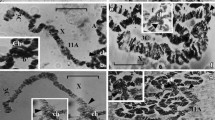Summary
The circadian rhythm phenotypes of eight chromosome aberrations with a breakpoint in the region of the per locus (3B1-2) were analyzed. Two duplications and five deficiencies with a 3B1-2 breakpoint produce either a wild-type or an arrhythmic clock phenotype while one translocation with a 3B1-2 breakpoint, T(1;4)JC43, produces locomotor-activity rhythms with either very-long period (31–39 h), rhythms that grade into arrhythmicity, or completely arrhythmic phenotypes. This is a unique phenotype that had not previously been observed for mutants at the per locus. An extensive complementation analysis of 3B1-2 chromosome aberrations and per mutant alleles provided no compelling evidence for genetic complexity at the per locus. This is in contrast to the report of Young and Judd (1978). Analysis of both the locomotor-activity and eclosion phenotypes of 3B1-2 chromosome aberrations did not uncover differences in the genetic control of these two rhythms. The clock phenotypes of 3B1-2 chromosome aberrations, the three per mutant alleles, and per + duplications suggest that mutations at the per locus shorten, lengthen, or eliminate periodicity by respectively increasing, decreasing, or eliminating per activity.
Similar content being viewed by others
References
Bruce V (1976) Clock mutants. In: Hastings J, Schweiger H (eds) The molecular basis of circadian rhythms. Dahlem Konferenzen, Berlin, pp 339–352
Enright J (1965) The seach for rhythmicity in biological time-series. J Theoret Biol 8:426–468
Feldman J, Gardner G, Denison R (1979) Genetic analysis of the circadian clock of Neurospora. In: Suda M, Hayaishi O, Nakagawa H (eds) Biological rhythms and their central mechanism. Elsevier, North-Holland Biomedical Press, Amsterdam, pp 57–66
Judd B (1977) The nature of the module of genetic function in Drosophila. In: Bradbury E, Javaherian K (eds) The organization and expression of the eukaryotic genome. Academic Press, London, pp 469–483
Judd B, Shen M, Kaufman T (1972) The anatomy and function of a segment of the X-chromosome of Drosophila melanogaster. Genetics 71:139–156
Konopka R (1972) Circadian clock mutants of Drosophila melanogaster. Ph. D. thesis, California Institute of Technology, Pasadena
Konopka R (1979) Genetic dissection of the Drosophila circadian system. Fed Proc 38:2602–2605
Konopka R, Benzer S (1971) Clock mutants of Drosophila melanogaster. Proc Natl Acad Sci USA 68:2112–2116
Konopka R, Orr D (1980) Effects of a clock mutation on the subjective day: Implications for a membrane model of the Drosophila circadian clock. In: Hall J, Hall L (eds) Development and neurobiology of Drosophila. Plenum Press, New York, pp 409–416
Lefevre G Jr (1951) Drosophila melanogaster — new mutants. Dros Infor Serv 25:71
Lefevre G Jr (1973) The one band-one gene hypothesis: evidence from a cytogenetic analysis of mutant and nonmutant rearrangement breakpoints in Drosophila melanogaster. Cold Spring Harb Symp Quant Biol 38:591–599
Lefevre G Jr (1974) The relationship between genes and polytene chromosome bands. Annu Rev Genet 8:51–62
Lefevre G Jr (1976) A photographic representation and interpretation of the polytene chromosomes of Drosophila melanogaster salivary glands. In: Ashburner M, Novitsky E (eds) The Genetics and biology of Drosophila, vol 1a. Academic Press, London, pp 1–66
Lindsley D, Grell E (1968) Genetic variations of Drosophila melanogaster. Carnegie Inst, Washington Publ 627
Liu C, Lim J (1975) Complementation analysis of methyl methane sulfonate-induced recessive lethal mutations in the zeste-white region of the X-chromosome of Drosophila melanogaster. Genetics 79:601–611
Pittendrigh C (1974) Circadian oscillations in cells and the circadian organization of multicellular systems. In: Schmitt F, Worden F (eds) The Neurosciences: Third study program. MIT Press, Cambridge, MA
Spradling A (1980) The structure and expression of Drosophila chorion genes. Carnegie Inst. Washington Year Book 79:73–78
Young M (1975) Nonessential sequences, genes, and the polytene chromosome bands of Drosophila melanogaster. Ph. D. thesis, Univ of Texas, Austin
Young M, Judd B (1978) Nonessential sequences, genes, and the polytene chromosome bands of Drosophila melanogaster. Genetics 88:723–742
Author information
Authors and Affiliations
Additional information
Communicated by M.M. Green
Rights and permissions
About this article
Cite this article
Smith, R.F., Konopka, R.J. Circadian clock phenotypes of chromosome aberrations with a breakpoint at the per locus. Molec. Gen. Genet. 183, 243–251 (1981). https://doi.org/10.1007/BF00270625
Received:
Issue Date:
DOI: https://doi.org/10.1007/BF00270625




